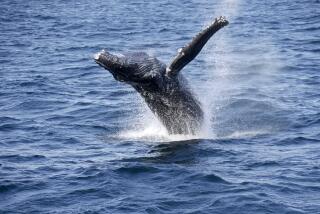Orcas Are Paying a Price for Their Popularity
SEATTLE — Fifty years ago, fishermen were still shooting at Northwest killer whales they thought were eating too many salmon.
Now, thousands of visitors pay an average of $75 a trip to see the orcas in their summer habitat around the San Juan Islands.
“No doubt the perception of these whales has changed from something to be feared and destroyed to something to be hugged,” said orca expert Ken Balcomb of the Center for Whale Research in the San Juan. “And now along comes too much hugging.”
The turnaround began when killer whale Namu was caught accidentally in a fishing net in 1965. He became a Seattle waterfront sensation until his death a year later, helping create a demand for orcas in the booming new marine-aquarium trade. Dozens were caught and shipped, but just two survive -- Lolita at the Miami Seaquarium and Corky at Sea World in San Diego.
As it turned out, “the capture program was part of the education process,” Balcomb said.
Northwest captures were stopped, though the resident population -- which now numbers 87 -- is still struggling to recover to pre-capture levels, believed to have been about 120.
“I’d settle for 101,” said Balcomb, who has been studying them for 30 years.
Now orcas -- which can grow 32 feet long, as big as a bus -- are prime examples of what researchers call “charismatic megafauna”: big critters with a passionate human following.
Thirty companies compete in a thriving whale-watching industry. Eighty boats -- seating anywhere from six to 212 -- ply the waters between British Columbia and Washington state. As many as half a million visitors a year take the tours or watch orcas from recreational craft.
But are people loving them to death?
Resident orcas that chase salmon on both sides of the border have been declared endangered by U.S. and Canadian authorities. Along with general vessel traffic, pollution and declining salmon runs, researchers are concerned about the tour boats. Both countries have federal monitors on the water during the peak season.
The industry obviously has tremendous incentive not to harm the whales.
“Not only not to do harm, but we want to do everything in our power to make them flourish,” said Shane Aggergaard of Anacortes-based Island Adventures, president of the Whale Watch Operators Assn. Northwest.
But with as many as 100 boats on the water at times, all the attention can be a problem.
“Anyone who’s been in a crowded bar at night trying to talk to the person next to you should understand what that’s like,” said Mark Pakenham in Victoria, British Columbia, who has worked with Canada’s federally funded monitoring program.
At a recent U.S.-Canada symposium on how to help the population, University of Washington researcher David Bain reported declines in foraging of more than 30% when boats were present. The impact was greater when boats were closer.
Federal law requires vessels to cut their engines at 400 feet and to stay at least 100 yards away to avoid harassing the whales or hindering their ability to find prey through echolocation.
“I think it would help if we enforced the rules we’ve got,” Bain said.
Last summer, a whale bumped a whale-watching boat skippered by Brett Soberg of Victoria-based Eagle Wing Tours. The boat was not moving, and Soberg quickly alerted authorities.
The violation probably would not have been noticed without Soberg’s coming forward, said Kari Koski at the Whale Museum in the San Juan Islands, the hub of Washington state orca activity. Koski is director of Soundwatch, the U.S. monitoring effort.
That first U.S. whale-watching violation is still under investigation by the National Marine Fisheries Service.
The whales were playing and changing direction, said Balcomb, who witnessed the encounter. “You couldn’t have predicted it.... You couldn’t blame the operator.”
But that doesn’t mean there should be no consequences for the skipper, he said.
The whale involved was K-25, Balcomb said. “He’s the one who showed up with a divot out of his back,” though apparently with no lasting injury, Balcomb said.
Soberg had been chided earlier by the Canadians for repeatedly parking in the path of the whales. It’s a common violation, as vessels jockey for the best vantage point. “Last year we recorded about 800 incidents in the summer ... and about 550 were for parking in the path of whales,” Pakenham said.
Talks on changes in whale-watching guidelines -- the government’s and the industry’s -- are ongoing.
Balcomb suggests that the industry vessels travel as a group. “To people onshore and on other boats, it looks like a free-for-all out there,” he said.
In August 2002, Canada prosecuted two whale-watching boat skippers for operating their vessels while surrounded by orcas. Both were fined $6,500.
Last year, the federal government declared Washington state’s three salmon-eating resident pods -- dubbed J, K and L -- an endangered species, which calls for habitat protection. Many Northwest salmon runs also are protected.
Exactly how to make things right is still under discussion.
More to Read
Sign up for The Wild
We’ll help you find the best places to hike, bike and run, as well as the perfect silent spots for meditation and yoga.
You may occasionally receive promotional content from the Los Angeles Times.






